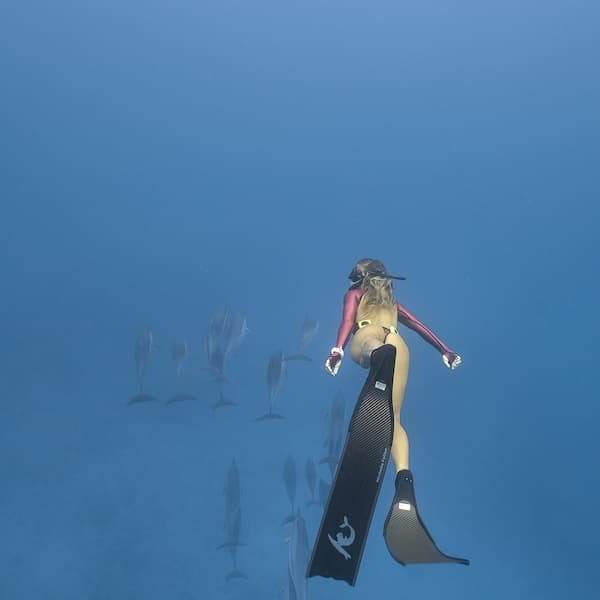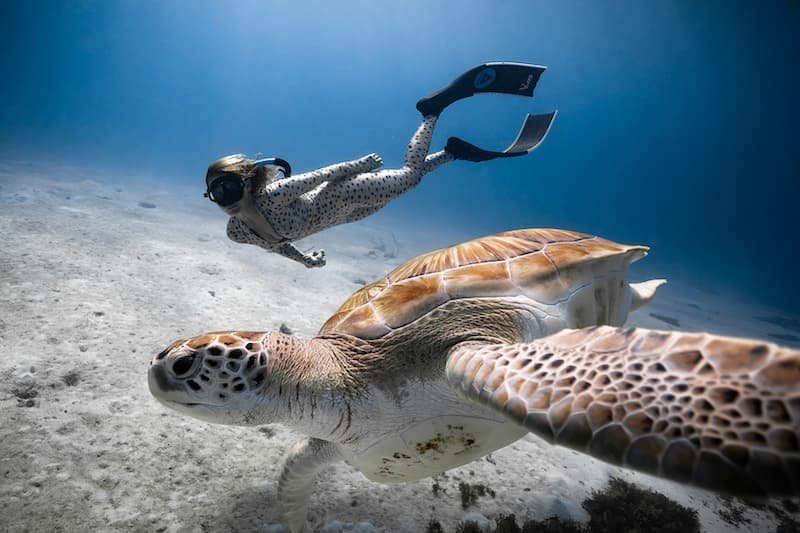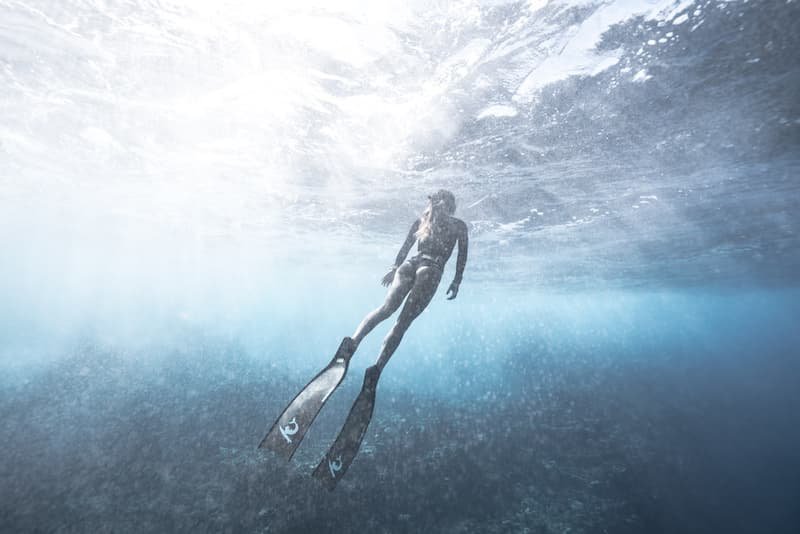
 Olivia Møller
Freediver - Activist - Explorer
Olivia Møller
Freediver - Activist - Explorer

 Olivia Møller
Freediver - Activist - Explorer
Olivia Møller
Freediver - Activist - Explorer
The stunning realm beneath the water’s surface has captivated humanity for centuries, but it wasn’t until recent decades, with the advent of modern underwater photography, that the beauty and plight of marine ecosystems could be captured and widely shared. Underwater photography has become a powerful tool for marine conservation, allowing audiences around the world to witness the magnificence of marine life and the threats it faces. With stunning images that capture biodiversity and the harsh realities of pollution, climate change, and habitat degradation, underwater photographers play a crucial role in spreading awareness, influencing policies, and driving change. As conservation photography gains traction, it offers not only aesthetic value but also acts as a visual catalyst for environmental stewardship.
Visual storytelling has always been an effective way to communicate complex issues, and in the case of marine conservation, it serves as an accessible platform for audiences to grasp the challenges our oceans face. Underwater photographers have an innate ability to capture the unseen—whether it's the haunting beauty of a coral reef, the elegance of a manta ray, or the devastating impact of plastic pollution. Studies have shown that visual media, including photography, has a unique ability to elicit emotional responses and increase empathy in viewers. For example, research published in Science Communication found that images can significantly impact an audience's perception of environmental issues, leading to greater engagement and even behavior change. In marine conservation, photographs that illustrate the contrast between thriving ecosystems and damaged ones can serve as powerful reminders of what we stand to lose.
Photographers like Paul Nicklen and Cristina Mittermeier, co-founders of the conservation group SeaLegacy, have proven that images can mobilize communities and influence policy decisions. By photographing everything from dying corals to distressed sea creatures tangled in nets, these photographers create a visual narrative that is both impactful and scientifically significant. In an age of short attention spans and social media dominance, these photos serve as immediate, digestible pieces of information that can resonate with millions. When people see a photograph of a turtle choking on plastic or a bleached coral reef, the visceral reaction they experience can often lead to a deeper understanding of the issues and a desire to act.

One of the most pressing issues in marine conservation today is pollution, especially plastic waste. Underwater photographers have documented countless instances of marine creatures interacting with plastic, from fish trapped in plastic bags to seabirds and sea turtles ingesting bits of debris. According to the World Wildlife Fund (WWF), an estimated 8 million tons of plastic enter the ocean each year. These plastics not only pollute the water but also break down into microplastics that contaminate the food chain, impacting marine life and human health alike. Photographs that capture the haunting reality of marine pollution play a pivotal role in spreading awareness and urging people to reduce their plastic usage.
In 2017, Justin Hofman’s iconic photo of a seahorse clinging to a discarded cotton swab went viral, becoming a symbol of ocean pollution. The image sparked widespread public outrage and calls for change, demonstrating the power of photography to bring attention to environmental issues. The photograph underscored the urgency of the issue, illustrating how even the most seemingly harmless items can have devastating consequences for marine life. This image, like many others documenting plastic pollution, has influenced policies and campaigns worldwide. Countries like Canada, which banned single-use plastics, have cited such powerful visuals as catalysts for their legislative changes.

Climate change is another critical area where underwater photography has made significant contributions to marine conservation. Coral bleaching, ocean acidification, and rising sea levels are among the consequences of climate change that underwater photographers document. Coral reefs, which support approximately 25% of all marine species, are particularly vulnerable. When ocean temperatures rise, corals expel the algae that provide them with food and color, resulting in “bleaching.” If the water temperature does not return to normal, the coral may die, leading to the collapse of entire ecosystems. The Great Barrier Reef in Australia, one of the world’s most famous reef systems, has experienced severe bleaching in recent years, losing over half its coral cover in just three decades.
The visual documentation of coral bleaching events has been instrumental in bringing global attention to the climate crisis. For instance, a 2020 study in Frontiers in Marine Science highlighted that before-and-after photographs of bleached versus healthy reefs can enhance public awareness and galvanize action against climate change. These images starkly contrast the vibrant, life-supporting environments that reefs should be with the ghostly, bleached coral skeletons left after bleaching events. By capturing these changes over time, photographers are creating a visual record of the impacts of climate change, offering tangible evidence that can support environmental advocacy.

Underwater photography also plays a role in influencing environmental policy and securing funding for conservation projects. Photographs of endangered species, such as sharks, sea turtles, and marine mammals, help communicate the urgent need for action to preserve biodiversity. Policymakers and organizations often leverage these images in reports, fundraising campaigns, and educational materials. For example, the International Union for Conservation of Nature (IUCN) frequently uses photographs of endangered marine species to highlight the importance of conservation action and to secure funding for projects aimed at protecting critical habitats.
Photographers like Brian Skerry have documented the lives of endangered marine species for publications like National Geographic, helping to illustrate the direct impact of human activity on marine ecosystems. Skerry’s work, particularly his images of sharks, has helped shift public perception of these animals from fearsome predators to misunderstood creatures crucial for ocean health. This shift has, in turn, influenced policy in countries like the Bahamas, which banned shark fishing after a concerted campaign that included stunning visuals of sharks in their natural habitats. Such efforts underscore the potential for photography to drive legislative change and reinforce the need for protected marine areas.

Another exciting intersection between underwater photography and marine conservation is citizen science. With the increasing availability of high-quality cameras and smartphones, amateur divers and underwater enthusiasts can now contribute to scientific research through photography. Platforms like iNaturalist and Reef Check allow individuals to document marine life, contributing valuable data to researchers studying biodiversity, invasive species, and the effects of climate change. According to the National Oceanic and Atmospheric Administration (NOAA), citizen science data has become an invaluable resource in monitoring marine ecosystems, particularly in remote areas that may lack formal scientific oversight.
For example, divers are often the first to notice changes in marine environments, such as the arrival of invasive species or unusual algal blooms. By photographing these occurrences, they provide scientists with data that can be analyzed to understand larger trends. In the Caribbean, citizen scientists have documented the spread of lionfish, an invasive species that threatens local fish populations. Through photos, divers help researchers track the lionfish population and implement control measures. This collaboration between amateur photographers and scientists exemplifies how underwater photography can support conservation beyond just raising awareness.

Alchemy, a brand committed to high-performance and sustainable diving gear, understands the impact that underwater photography can have on conservation. Alchemy collaborates with a community of creators who not only capture the beauty of the underwater world but also advocate for its preservation. These photographers and videographers, equipped with Alchemy’s fins and other gear, are instrumental in promoting responsible diving and highlighting environmental issues. Through breathtaking visuals and educational content, they inspire a deeper appreciation for the ocean and encourage their audiences to protect it.
Despite its potential for impact, conservation photography comes with its own set of challenges. The cost of equipment, travel expenses, and the physical demands of diving in sometimes hazardous conditions can be significant barriers for photographers. Additionally, documenting issues like marine pollution or endangered species can be emotionally taxing. Seeing firsthand the extent of damage to marine ecosystems can lead to feelings of helplessness, frustration, and even burnout among photographers. According to a 2022 survey published in Conservation Science and Practice, over 60% of conservation photographers reported experiencing mental health challenges related to the emotional burden of their work.
Moreover, conservation photographers sometimes face opposition from communities or industries that benefit from unsustainable practices. For example, documenting illegal fishing or pollution from industrial waste can place photographers in potentially dangerous situations. Despite these obstacles, many photographers continue their work, driven by a passion for the ocean and a commitment to conservation. Organizations like the International League of Conservation Photographers provide support, networking, and funding opportunities to help conservation photographers continue their impactful work.

The power of underwater conservation photography lies not only in the hands of the photographers but also in the actions of those who view their work. There are several ways individuals can support these efforts. First, following conservation photographers and organizations on social media and sharing their content can help amplify their message. Platforms like Instagram and Facebook allow users to easily disseminate powerful visuals, reaching audiences that may otherwise remain unaware of marine conservation issues. Additionally, supporting non-profit organizations that fund conservation photography or purchasing prints directly from photographers can provide financial backing for these often self-funded projects.
For those who dive or snorkel, capturing your own underwater images and sharing them responsibly can also contribute to conservation. Many photographers encourage ethical underwater photography practices, such as avoiding contact with marine life, not using flash in sensitive ecosystems, and ensuring that images don’t misrepresent marine species or environments. Ethical photography helps maintain the integrity of marine habitats while allowing photographers to document their beauty and importance.